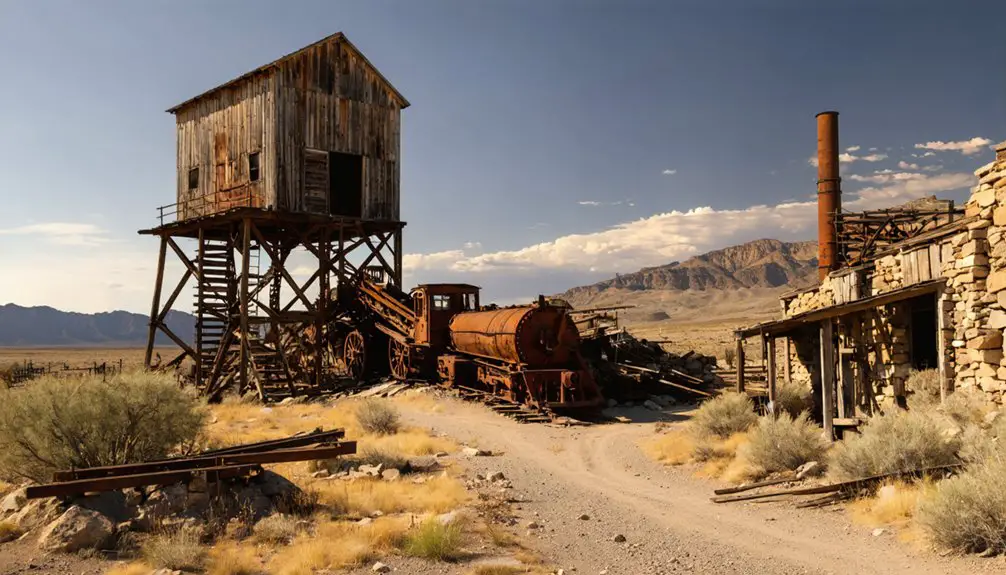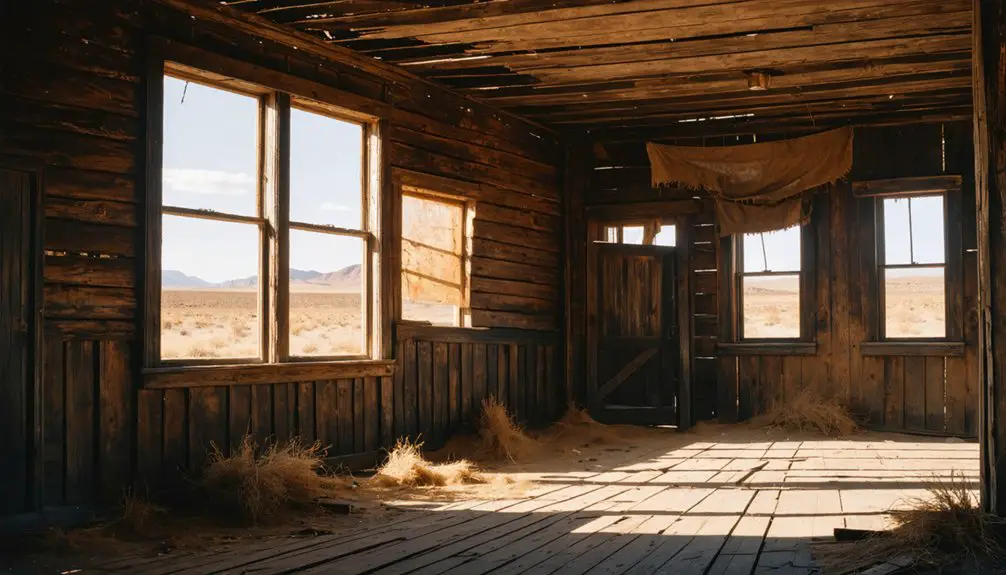You’ll find Helene, Nevada one mile north of Delamar, where gold discoveries in 1890 transformed Pahranagat Valley farmland into a bustling mining settlement. The town centered around the Magnolia Mine, establishing a post office and newspaper by 1892. While operations processed up to 260 tons of ore daily during its peak, Helene’s prosperity proved short-lived, with its post office closing in 1894. The site’s stone foundations and mine structures still tell tales of Nevada’s golden age.
Key Takeaways
- Helene was established in 1890 after gold discovery in Nevada’s Pahranagat Valley, growing from a tent settlement into a mining community.
- The town centered around the Magnolia Gold Mine, which processed up to 260 tons of ore daily during peak operations.
- Helene featured a post office and newspaper (Ferguson Lode) from 1892-1894, serving as a communication hub for Lincoln County.
- Located one mile north of Delamar, Helene’s gold-laden quartzite deposits yielded values between $75 and $1,000 per ton.
- Today, remnants of Helene’s mining operations can be explored near Delamar Ridge, including foundations and minehead structures.
The Birth of a Mining Camp
Two significant events marked the birth of Helene, Nevada in the early 1890s. First, Pahranagat Valley farmers discovered gold in the area in 1890, sparking immediate interest from prospectors.
Then, around 1892, the establishment of the Magnolia Gold Mine transformed the location into a bustling mining camp. Like many mining operations of the era, water proved essential for processing the precious ore.
You’ll find that Helene began as one of many tent settlements that dotted Nevada’s mining landscape during this period. Located just a mile north of the more prominent Delamar area, the camp quickly evolved beyond its canvas origins. Similar to how Johnny Peavine discovered silver in 1905 in nearby Tonopah, the area’s mineral wealth drew adventurous prospectors.
Stone buildings and wooden mining structures emerged to support the transient workforce. While smaller than its neighboring camps, Helene developed essential amenities, including a post office and its own newspaper, the Ferguson Lode, reflecting the determination of its early settlers.
Gold Rush and Early Development
When gold was discovered in the Delamar Mountains in 1889, you’d find prospectors rushing to establish claims around what would become Helene, drawn by the pure gold-laden quartzite deposits.
The camp’s explosive growth accelerated as hundreds of miners staked their claims, leading John De Lamar to consolidate numerous individual claims into the organized Delamar mining district.
The mining operations expanded rapidly to process 260 tons daily of rich ore from the mountainside claims.
Like the mother lode discoveries that sparked the Helena gold rush years earlier, these rich deposits attracted fortune seekers from across the region.
Early Mining Camp Formation
After local farmers discovered gold in the Delamar Mountains area in 1889, the region quickly attracted waves of prospectors seeking their fortunes.
Initial mining technology was basic, but ore assays showing values between $75 and $1,000 per ton sparked significant economic impact throughout the area.
You’ll find that Helene emerged as one of the first organized settlements around 1890, sprouting up near the promising Magnolia and Monkey Wrench claims.
The camp’s importance grew as rich gold-laden quartzite deposits drew hundreds of miners to the area.
Similar to the Clifford brothers’ discovery in 1905, which led to a successful $250,000 sale, early prospectors saw great potential in the region.
By 1892, Helene had established itself as a proper settlement with the opening of its post office and the region’s first newspaper, the Ferguson Lode.
The camp quickly developed essential infrastructure, including saloons and stores to support its growing mining population.
The town eventually lost its distinct identity when it was absorbed into Delamar by 1894.
Rich Claims Drive Growth
The rich gold-laden quartzite discoveries in Helene’s early claims sparked unprecedented growth throughout the Delamar Mountains region.
Similar to peak earnings era in Helena, Montana during the 1880s, prospectors flooded the area, implementing advanced mining techniques that would soon process up to 260 tons of ore daily. Early female prospectors endured back-breaking work as they joined the rush to stake claims in the harsh Nevada boomtown.
You’ll find that John De Lamar’s consolidation of individual claims into the formalized Delamar mining district proved transformative for the region’s economic impact.
Post Office Marks Recognition
Marking Helene’s emergence as a recognized settlement, the town’s post office opened its doors on June 30, 1892, during the height of the gold rush era. The post office’s significance extended beyond mail services, as it coincided with the launch of the region’s first newspaper, the Ferguson Lode, on September 5, 1892.
Together, these institutions fostered community identity and local information exchange. The town grew rapidly to include frame building structures as development progressed.
You’ll find that Helene’s postal prominence proved short-lived, as the office closed on December 22, 1894. This closure reflected the town’s eclipse by neighboring Delamar, which established its own post office in June 1894.
While Helene continued as a residential area for miners working in Delamar, the loss of its post office marked the beginning of its decline as an independent settlement.
Life in Helene’s Heyday
During its brief heyday from 1889 to 1894, life in Helene centered primarily around the lucrative Magnolia Mine, which yielded substantial gold deposits and spurred the development of basic community services.
The mining lifestyle you’d have experienced involved living in simple, scattered housing structures amid the rugged canyon terrain. Community dynamics revolved around essential amenities like the post office and the Ferguson Lode newspaper, which kept residents connected and informed.
You’d have endured harsh weather conditions, with scorching summers and cold winters while working the mines. Unlike its larger neighbor Delamar, Helene maintained a modest, temporary population that fluctuated with mining prospects.
The town’s infrastructure remained basic, focused on supporting mining operations rather than establishing permanent civic institutions.
The Rise and Fall of the Community

Economic shifts soon followed when John De Lamar consolidated the area’s claims, but the town’s prosperity wouldn’t last.
A devastating fire in 1900, coupled with depleting ore quality and the 1907 financial panic, triggered Helene’s decline.
Though a brief revival occurred during the Great Depression with renewed mining operations, the final mail delivery in 1941 marked the end of this once-promising community.
Historical Landmarks and Remains
Today’s visitors to Helene encounter a rich tapestry of mining-era ruins scattered across the desert landscape.
You’ll find stone foundations and partial walls crafted from native rock, alongside dilapidated cabins that showcase late 19th-century mining camp architecture. The prominent tailings pile atop the canyon marks the historic Magnolia Mine site.
During your ruins exploration, you’ll discover remnants of substantial mill sites and ore processing infrastructure.
The Delamar Helene Cemetery, shared with nearby Delamar, offers a poignant glimpse into the lives of former residents through weathered tombstones and epitaphs.
While ghost town preservation efforts focus primarily on Delamar, Helene’s primitive state allows you to experience an authentic, untouched piece of mining history amid the rugged terrain between the Delamar Mountains and South Pahroc Range.
The Magnolia Mine Legacy

When prospectors discovered the Magnolia Mine in March 1892, they sparked the establishment of Helene, a mining camp that would shape Lincoln County’s mineral development. The mine’s economic impact quickly attracted investors like Hartwig A. Cohen, who named the settlement after his wife.
You’ll find that mining techniques evolved throughout the mine’s operation, from early excavations to more organized production in the 1920s and early 1930s under J.L. Baird and W.L. Aiken’s leases.
Though the mine supported postal services and commerce from 1892 to 1894, its prosperity proved fleeting.
Today, you can explore the remnants of this once-bustling operation near Delamar Ridge, where foundations, minehead structures, and scattered artifacts tell the story of Nevada’s dynamic mining heritage and the transient nature of boomtown prosperity.
Media and Communication Hub
Through its brief but vibrant existence, Helene established itself as a significant media and communication center in Lincoln County, anchored by the Ferguson Lode newspaper’s debut on September 5, 1892.
The town’s print media and postal services created essential communication networks that connected miners, residents, and neighboring camps.
You’ll find historical documentation of Helene’s dynamic mining journalism preserved in oral histories and archives at institutions like the University of Nevada at Las Vegas.
- The Ferguson Lode evolved into the Pioche Lode before merging with Delamar’s De Lamar Lode
- Helene’s post office operated from June 30, 1892, to December 22, 1894
- Oral histories and photographs capture the town’s social fabric and communication patterns
- The town’s proximity to Caliente and Delamar enhanced regional information exchange
Frequently Asked Questions
What Was the Average Temperature and Climate in Helene During Its Operation?
You’d experience extreme temperature variations in Helene, with average climate ranging from freezing winters to scorching 100°F+ summers, while spring and fall maintained comfortable 60-80°F temperatures.
How Did Residents Get Their Water Supply in This Remote Mining Camp?
You’d have relied on hauled water from distant locations, shallow wells, or nearby springs, adapting common mining techniques of the era that used minimal water sources for both domestic and operational needs.
Were There Any Notable Crimes or Lawlessness Incidents in Helene?
Picture a dusty frontier outpost where you’d expect tales of gunfights, but there aren’t any documented crime incidents or law enforcement records from Helene, though lawlessness was common in similar mining towns.
What Happened to the Original Residents After Helene Was Abandoned?
You’ll find the residents primarily moved to Delamar for mining work, while others sought opportunities elsewhere. Their post-abandonment migration strategies included shifting to related industries or leaving Nevada’s mining regions entirely.
Did Any Famous People or Historical Figures Ever Visit Helene?
Like footprints in shifting desert sands, famous visitors left little trace in Helene. You’ll find only Captain John De Lamar, the copper magnate, and local pioneers Ferguson and Sharp made historically significant appearances.
References
- https://westernmininghistory.com/towns/california/helena/
- https://www.desertusa.com/desert-activity/nevada3a.html
- https://travelnevada.com/ghost-town/delamar-ghost-town/
- https://nvtami.com/2024/01/17/lincoln-county-ghost-towns/
- https://nevadamagazine.com/issue/february-april-2022/19231/
- https://www.nvexpeditions.com/nye/clifford.php
- https://nvtami.com/2021/12/30/tunnel-camp-nevada-ghost-town/
- https://www.nvexpeditions.com/lincoln/helene.php
- https://nevadamagazine.com/issue/september-october-2019/11256/
- http://svcalt.mt.gov/education/textbook/chapter6/childrenintheminingcamps.pdf



